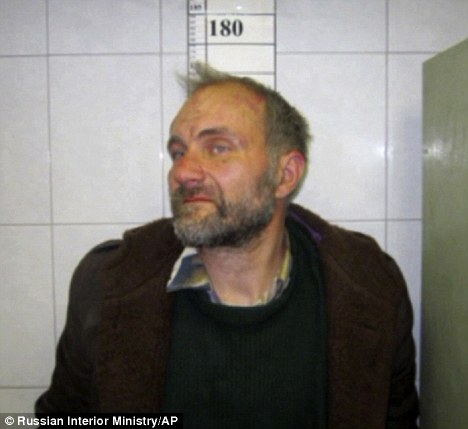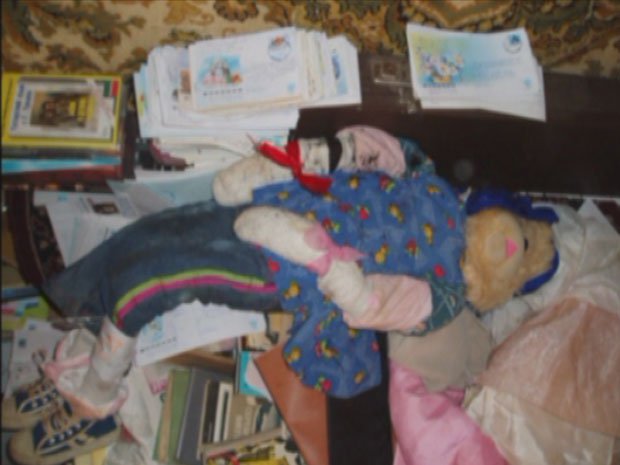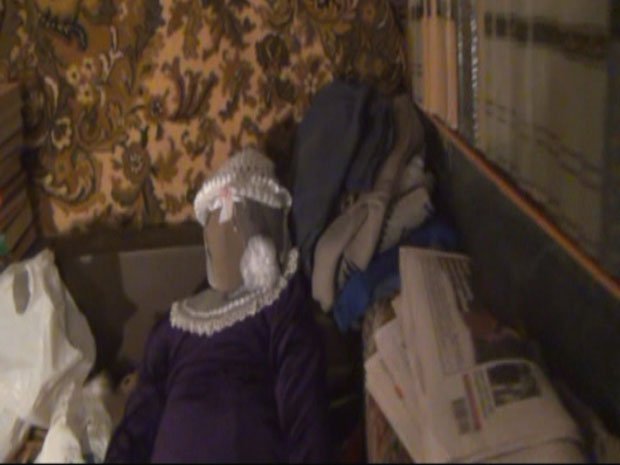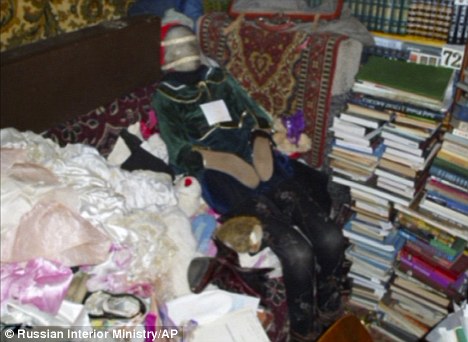
|
|||
Russian Historian Anatoly Moskvin Collected Dead Girls & made dolls from girls' corpses' - Unexplained Mysteries
See more at: http://www.thedailybeast.com
Russian historian Anatoly Moskvin searched cemeteries for the bodies of young women and girls so that he could store them in his apartment like a collection of ghoulish dolls. Russian grave-robber hailed a genius ‘kept mummified female corpses dressed as dolls’ Anatoly Moskvin is said to have dug up the corpses from hundreds of cemeteries and took them to his small, three-bedroom flat in Nizhny Novgorod, according to local media. He was said to have carried the ‘dried up’ remains of at least 29 women – all aged between 15 and 26 – in plastic bags. His ghastly obsession was uncovered when Moskvin’s parents visited him in the town around 200 miles east of Moscow after returning from a holiday. Moskvina, a historian and journalist described by neighbours as a ‘genius’, sometimes slept in a coffin or on graveyard benches, said BNO News. Moskvina was said to have visited more than 750 cemeteries in western Russia to indulge his fantasies, although it was not clear when he had begun exhuming graves. He is said to speak 13 languages and have a vast knowledge of history – on which he used to lecture at a local museum. It all started with an occult ceremony In his last article, published in Necrologies on Oct. 26, Moskvin confessed what had inspired his obsession with the dead. He describes how back in 1979, when he was 13, he was stopped by people in black suits on his way from school, dragged to a coffin containing the body of an 11-year-old girl named Natasha Petrova, and forced to kiss the dead girl. “I kissed her once, then again, then again,” Moskvin said in the newspaper article. The mystical ritual ended with the girl’s mother putting wedding rings on Moskvin’s and the dead girl’s fingers. “My strange marriage with Natasha Petrova was useful,” Moskvin recalled, as the experience helped him to develop a deep interest in “serious magic ceremonies.” On a cold, gray morning last weekend, a group of about 30 relatives and neighbors waited for the funeral of a 65-year-old woman outside a five-story building on Lenin Prospect in the Russian city of Nizhny Novgorod. Some of them discussed the latest news in low voices: “Our Rima Stesheva would be too old for that maniac! He dragged home only the corpses of young women,” one of the women at the funeral said, referring to the deceased. “They said he placed musical boxes inside the mummies, set them up around his living room and had tea, while they were singing for him,” another woman said, citing a recent article from a local newspaper. Soul-troubling details settled over the crowd, like wet snow, as more pedestrians joined the discussion in the courtyard: “He dug them out at night and turned the remains into pretty dolls”; “He collected clothes of dead women”; “His apartment was packed with the mummies he made out of dead bodies.” The moment the coffin showed up from the doorway, the gloomy-faced crowd quieted and boarded a bus to follow the deceased one to the cemetery. Some Nizhny Novgorod papers nicknamed the villain of the story “The Lord of the Mummies”; others opted for “Perfumer,” after the Patrick Suskind novel Perfume. The thriller began on Nov. 3, a day before President Dmitry Medvedev and Prime Minister Vladimir Putin’s official visit to Nizhny Novgorod, Russia's fourth-largest city and a center of military research and production that stayed closed to foreigners during most of the Soviet era. The reporters working on the Perfumer story were told not to make any noise on the story before the leaders left the city. But a news site named Criminal Chronicle could not contain itself: it ran a short brief saying that center “E," the Interior Ministry’s department for fighting extremist crime, had discovered 29 mummified corpses of women and girls between the ages of 15 and 26 in a three-room apartment that belonged to Anatoly Moskvin, a 45-year-old scientist. A ghoulish collection of necro-dolls gathered by an obsessive cemetery expert and uncovered by police has shocked residents of the Russian city of Nizhny Novgorod. RT has obtained a copy of shocking footage made by police who searched his apartment. Piles of gravestone plaques stocked on the shelves, maps of graves scattered around the tables, a bone here or there, or a skull – it can safely be said that the apartment’s owner, Anatoly Moskvin, is a big fan of cemeteries. But what tops it all is a personal harem of 29 female corpses aged 12 to 30 (age given at the moment of undertaking). Dressed in decrepit clothing, they are carefully set up in various poses throughout the three-room apartment.
Not many echoed Yesin’s praise of Moskvin’s research after the investigators working on the scene released a video of what they discovered inside the historian’s apartment. In the clip, the camera moves along the corridor, which is cluttered with wedding dresses and bright, colorful clothes, and enters a small room. At first sight, the little figures of girls mounted on top of the bundles of old books and papers, or half-lying on the couches, could be taken for big, soft stuffed dolls. The camera zooms in to their faces, which are wrapped in light beige fabric, and settles on the painted eyes. The girl figure on the couch wears a knitted hat with a pinned rose and a lilac sweater; her legs, covered by white tights, are elegantly crossed. The camera moves down to the feet; the girl is wearing white shoes. The next “doll” in the corner has long, curled, blonde hair and wears a silk wedding dress with a veil running down to the floor. She could be 10 or 12 years old. “These dolls are made of mummified human remains,” the voiceover on the video says. The police report says that Moskvin compiled up-to-date information about the life of each of the women he brought home, and printed off from a computer detailed “instructions for producing” the “dolls” out of human remains. The police officers who shot the video said they each drank a few shots of Vodka when they got home.  Moskvin’s neighbors described themselves as “depressed” and “traumatized” about what they had learned from police reports about the person next door. “The scariest part to me of what he kept there was the hundreds of pieces of clothing he brought home from the cemeteries,” said a neighbor, who would not give her name. She lives one floor down from Moskvin’s apartment. She still referred to Moskvin as “the most respectful and intelligent person.” Even the sweet, stinky aura that their hallway and staircase filled up with every time Moskvin opened his door did not seem suspicious. “Our buildings all stink of something that rots in the basements,” a middle-aged neighbor named Galina Riabova said. Riabova liked to spend her afternoons in the courtyard, she said, and had often seen Moskvin, a skinny-looking man, carrying heavy backpacks or black plastic bags. “His respectable parents and friends surely knew about his psychiatric sickness, but nobody sent him to the hospital for treatment,” Riabova said, expressing deep sympathy for the victims’ relatives, who would have to identify their once buried beloved ones from the collection of Moskvin’s “dolls.” "From what I hear, the most probable diagnosis for Moskvin’s psychological problem is necrophilia and situational fetishism," says psychiatrist Yan Goland. Yesin, Moskvin’s editor, said he “felt reluctant” to continue publishing further installments describing Moskvin’s love affair with dead Natasha. “Many of his articles enlighten his sensual interest in deceased young women, which I took for romantic and somewhat childish fantasies the talented writer emphasized,” Yesin admitted.  To the head of the Korefei Center for Psychological Rehabilitation, psychiatrist Yan Goland, Moskvin’s case sounds clear. “From what I hear, the most probable diagnosis for Moskvin’s psychological problem is necrophilia and situational fetishism. We have helped a few patients obsessed with sexual attraction to the dead at this center,” Goland said. Moskvin has apparently not received psychological treatment from the authorities. The official information released by the government is that the scientist will be tried as if he were entirely sane.  Several historians quit their collaboration with Moskvin on joint research projects this year after hearing his disturbing comments. In his last phone conversation with his colleague Yulia Zadorozhna, a historian from the Balakhna region, Moskvin criticized her for not researching inside the graves. “He told me I was not a real necropolyst, since I studied only the archives and not the skeletons. What would I need the skeletons for!” Zadorozhna sounded astonished. Her last research was devoted to collecting information about 18th- and 19th-century war veterans buried in her region. Moskvin doubted the accuracy of her research, since she based it on church archives, “instead of digging out the remains, as he would have done it.” But nobody knew more about Moskvin’s devotion to grave studies than the director of Books publishing house Oleg Riabov, who three years ago commissioned Moskvin to summarize the list of dead in more than 700 cemeteries in 40 regions of the Nizhny Novgorod administrative division. Today Riabov said he was happy that Moskvin’s giant project had never been published, but acknowledged he was feeling sorry for the scientist. “This is a tragedy, that the investigation accuses Moskvin as if he were a sane person. We fear that instead of being treated properly in the hospital, he is going to be killed in jail.” The only photograph of Moskvin released by police after his arrest suggests signs of beatings on his swollen face. comments powered by Disqus Submit News/Videos/Links | Discuss article | Article Link | More Unsolved and Unexplained Mysteries |
More can be addded on request. Direct your requests at vinit@theunexplainedmysteries.com
